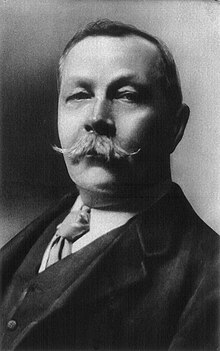About the Book:"The Adventure of the Musgrave Ritual" is a short story by Arthur Conan Doyle, featuring his fictional detective Sherlock Holmes. The story was originally published in Strand Magazine in 1893, and was collected later in The Memoirs of Sherlock Holmes. Unlike the majority of Holmes stories, the main narrator is not Doctor Watson, but Sherlock Holmes himself. With Watson providing an introduction, the story-within-a-story is a classic example of a frame tale. It is one of the earliest recorded cases investigated by Holmes, and establishes his problem solving skills.
"The Adventure of the Musgrave Ritual" shares elements with two Edgar Allan Poe tales: "The Gold Bug" and "The Cask of Amontillado".
In 1927, Conan Doyle ranked the story at 11th place on his top 12 Holmes stories list. The story did better in a 1959 chart produced by the Baker Street Journal, ranking 6th out of 10.
About the Author: Arthur Ignatius Conan Doyle was born on 22 May 1859 at 11 Picardy Place, Edinburgh, Scotland. From 1876 to 1881, he studied medicine at the University of Edinburgh, including a period working in the town of Aston (now a district of Birmingham) and in Sheffield, as well as in Shropshire at Ruyton-XI-Towns. While studying, Doyle began writing short stories. His earliest extant fiction, "The Haunted Grange of Goresthorpe", was unsuccessfully submitted to Blackwood's Magazine. His first published piece "The Mystery of Sasassa Valley", a story set in South Africa, was printed in Chambers's Edinburgh Journal on 6 September 1879. On 20 September 1879, he published his first non-fiction article, "Gelsemium as a Poison" in the British Medical Journal. In 1882 he joined former classmate George Turnavine Budd as his partner at a medical practice in Plymouth, but their relationship proved difficult, and Doyle soon left to set up an independent practice. Arriving in Portsmouth in June of that year with less than £10 (£900 today) to his name, he set up a medical practice at 1 Bush Villas in Elm Grove, Southsea. The practice was initially not very successful. While waiting for patients, Doyle again began writing stories and composed his first novels, The Mystery of Cloomber, not published until 1888, and the unfinished Narrative of John Smith, which would go unpublished until 2011. He amassed a portfolio of short stories including "The Captain of the Pole-Star" and "J. Habakuk Jephson's Statement", both inspired by Doyle's time at sea, the latter of which popularized the mystery of the Mary Celeste and added fictional details such as the perfect condition of the ship (which had actually taken on water by the time it was discovered) and its boats remaining on board (the one boat was in fact missing) that have come to dominate popular accounts of the incident. Doyle struggled to find a publisher for his work. His first significant piece, A Study in Scarlet, was taken by Ward Lock Co. on 20 November 1886, giving Doyle £25 for all rights to the story. The piece appeared later that year in the Beeton's Christmas Annual and received good reviews in The Scotsman and the Glasgow Herald. The story featured the first appearance of Watson and Sherlock Holmes, partially modeled after his former university teacher Joseph Bell. Doyle wrote to him, "It is most certainly to you that I owe Sherlock Holmes ... Round the center of deduction and inference and observation which I have heard you inculcate I have tried to build up a man." Robert Louis Stevenson was able, even in faraway Samoa, to recognize the strong similarity between Joseph Bell and Sherlock Holmes: "My compliments on your very ingenious and very interesting adventures of Sherlock Holmes. ... Can this be my old friend Joe Bell?" Other authors sometimes suggest additional influences—for instance, the famous Edgar Allan Poe character C. Auguste Dupin. A sequel to A Study in Scarlet was commissioned and The Sign of the Four appeared in Lippincott's Magazine in February 1890, under agreement with the Ward Lock company. Doyle felt grievously exploited by Ward Lock as an author new to the publishing world and he left them. Short stories featuring Sherlock Holmes were published in the Strand Magazine. Doyle first began to write for the 'Strand' from his home at 2 Upper Wimpole Street, now marked by a memorial plaque. In this period, however, Holmes was not his sole subject and in 1893, he collaborated with J.M. Barrie on the libretto of Jane Annie. Doyle was found clutching his chest in the hall of Windlesham Manor, his house in Crowborough, East Sussex, on 7 July 1930. He died of a heart attack at the age of 71. His last words were directed toward his wife: "You are wonderful." At the time of his death, there was some controversy concerning his burial place, as he was avowedly not a Christian, considering himself a Spiritualist. He was first buried on 11 July 1930 in Windlesham rose garden. He was later reinterred together with his wife in Minstead churchyard in the New Forest, Hampshire. Carved wooden tablets to his memory and to the memory of his wife are held privately and are inaccessible to the public. That inscription reads, "Blade straight / Steel true / Arthur Conan Doyle / Born May 22nd 1859 / Passed On 7th July 1930." The epitaph on his gravestone in the churchyard reads, in part: "Steel true/Blade straight/Arthur Conan Doyle/Knight/Patriot, Physician, and man of letters". Undershaw, the home near Hindhead, Haslemere, south of London, that Doyle had built and lived in between October 1897 and September 1907, was a hotel and restaurant from 1924 until 2004. It was then bought by a developer and stood empty while conservationists and Doyle fans fought to preserve it. In 2012 the High Court ruled that the redevelopment permission be quashed because proper procedure had not been followed. A statue honours Doyle at Crowborough Cross in Crowborough, where he lived for 23 years. There is also a statue of Sherlock Holmes in Picardy Place, Edinburgh, close to the house where Doyle was born.
My Review:In this story, Holmes recounts to Watson the events arising after a visit from a university acquaintance, Reginald Musgrave. Musgrave visits Holmes after the disappearance of two of his domestic staff, Rachel Howells, a maid, and Richard Brunton, the longtime butler. The pair vanished after Musgrave had dismissed Brunton for secretly reading a family document, the Musgrave Ritual. The Ritual, which dates from the 17th century, is a riddle set in verse form. It reads:'Whose was it?'
'His who is gone.'
'Who shall have it?'
'He who will come.'
('What was the month?'
'The sixth from the first.')
'Where was the sun?'
'Over the oak.'
'Where was the shadow?'
'Under the elm.'
'How was it stepped?'
'North by ten and by ten, east by five and by five, south by two and by two, west by one and by one, and so under.'
'What shall we give for it?'
'All that is ours.'
'Why should we give it?'
'For the sake of the trust.'
Musgrave caught Brunton in the library at two o'clock one morning. Not only had he unlocked a cabinet and taken out the document in question, but he also had what looked like a chart or map, which he promptly stuffed into a pocket upon seeing his employer watching him. Brunton besought Musgrave not to dishonour him by dismissing him, and asked for a month's time to invent some reason for leaving, making it seem as though he was leaving of his own accord. Musgrave granted him a week. The story later reveals that Brunton wanted the time for something else.
A few days later, Brunton disappeared, leaving behind most of his belongings. His bed had not been slept in. No sign could be found of him. The maid, Rachel Howells, who was also Brunton's former lover, had a hysterical fit when asked about Brunton's whereabouts, repeating over and over that he was gone. She was in such a state that another servant was posted to sit up with her at night. Eventually, however, the guarding servant nodded off one night, and the hysterical Rachel Howells escaped through a window. Her footprints led to the edge of the mere, and ended there. Musgrave had the mere dredged, but only a sack containing some rusty, mangled bits of metal, and some coloured stones or glass were found. Rachel Howells was never heard from again.
Holmes looked upon the case not as three mysteries, but as one. He considered the riddle of the ritual. It was a meaningless, absurd tradition to Musgrave, and apparently to all his ancestors going back more than two centuries, but Holmes — and Brunton, too, Holmes suspected — saw it as something very different. He quickly realized that it was a set of instructions for finding something. Ascertaining the height of the oak, which was still standing, and the position of the elm, which was now gone, Holmes performed a few calculations and paced out the route to whatever awaited him, with Musgrave now eagerly following him.
It was quite instructive to Holmes that Brunton had recently asked about the old elm tree's height as well, and that he was apparently quite intelligent.
The two men found themselves inside a doorway, momentarily disappointed, until they realized that there was the last instruction, "and so under". There was a cellar under where they were standing, as old as the house. Finding their way into it, they saw that the floor had been cleared to expose a stone slab with an iron ring on it. Holmes thought it wise to bring the police in at this point. He and a burly Sussex policeman manage to lift the slab off the little hole that it was covering, and inside, they found an empty, rotten chest, and Brunton, who had been dead for several days. There were no marks on him. He had likely suffocated.
Holmes then put everything together for his rather shocked client. Brunton had deduced the ritual's meaning, at least insofar as it led to something valuable. He had determined the elm tree's height by asking his master, had paced out the instructions — and Holmes had later even found a peg hole in the lawn made by Brunton — had found the hiding place in the old cellar, but then had found it impossible to lift the stone slab himself. So, he had been forced to draw someone else into his treasure hunt. He had unwisely chosen Rachel Howells, who hated him. The two of them could have lifted the slab up, but they would have needed to support it while Brunton climbed down to fetch the treasure. Did Rachel deliberately kick the support away, sealing Brunton in, thus murdering him? Or did the slab fall by itself and she was only guilty of not getting help to her unfaithful lover? It explained a great deal about her subsequent behaviour.
As to the relics found in the bag retrieved from the mere, Holmes examined them and found that the metal parts were gold and the stones were gems. He believed that it was no less than King Charles I's gold crown, being kept for his successor (who, as it turned out, was Charles II). The ritual had been a guide to retrieving this important symbol: Reginald confirms that one of his ancestors, Sir Ralph Musgrave, was a king's man. Holmes theorized that the original holder of the ritual had died before teaching his son about the ritual's significance. It had thus become nothing more than a quaint custom for more than 200 years.
Another masterpiece that you will enjoy reading and will keep you entertained for a couple of hours.
If you read this review, fell free to leave a comment!



No comments:
Post a Comment